‘A Cry For Help’: Federal Agency Eyes A New Kind Of Leasing To Safeguard Public Lands
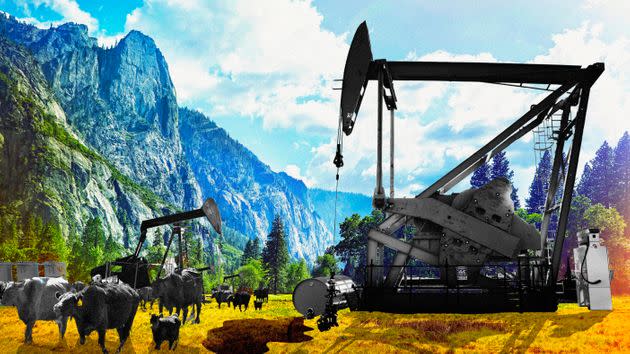
BOISE, Idaho — For decades, the federal government has incentivized drilling, mining, logging and livestock grazing on America’s public lands via antiquated laws and leasing programs dating back as far as the late 1800s. Never has there been a similar system for acquiring public lands in order to protect them, rather than exploit them.
That could soon change.
The Bureau of Land Management unveiled a draft rule late last month that would place conservation “on equal footing” with energy development and other traditional uses — a proposal that seeks to confront the agency’s long record of prioritizing extraction across the federal estate. A key provision of that rule would grant the BLM, which oversees one-tenth of all land in the United States, the authority to issue “conservation leases” to promote land protection and ecosystem restoration.
The rule would be a major shift in federal land management and could help the Biden administration achieve its goal of protecting 30% of America’s lands and waters by 2030 — better known as 30x30. The U.S. is still a long way from meeting that national conservation target on land: roughly 12% of all U.S. lands are now permanently protected, compared to 23% of waters, according to federal data.
Interior Secretary Deb Haaland called the proposal a “smart path to ensure healthy landscapes, abundant wildlife habitat, clear water and balanced decision-making on our public lands.”
“For too long, land management planning has been dominated by extractive industries,” she told reporters last month at the Society of Environmental Journalists’ annual conference. “This proposal is a long time coming and will go far to help address the growing pressures we’re seeing on our public lands from fossil fuel development and the impacts of the climate crisis.”
The leases would be made available to “restore public lands or provide mitigation for a particular action,” the rule states. People, organizations or companies would be able to sponsor lands for up to a decade, depending on the individual proposal, and public access of leased areas would generally remain open, although the agency notes some lands could be temporarily closed during restoration work.
While many of the details have yet to be worked out, environmental groups and public land advocates have widely celebrated the proposal as a key first step toward better management of America’s public lands.
“It’s a really exciting opportunity and it’s so timely,” Helen O’Shea, a renewable energy director at the Natural Resources Defense Council, told HuffPost. “I really do think public land managers are facing such unprecedented challenges right now. Time is not our friend.”
Conservation is not solely a use of federal lands, O’Shea stressed, but a strategy for combating climate change and biodiversity loss, as well as protecting communities whose livelihoods rely on public lands.
“It’s an investment,” she said.
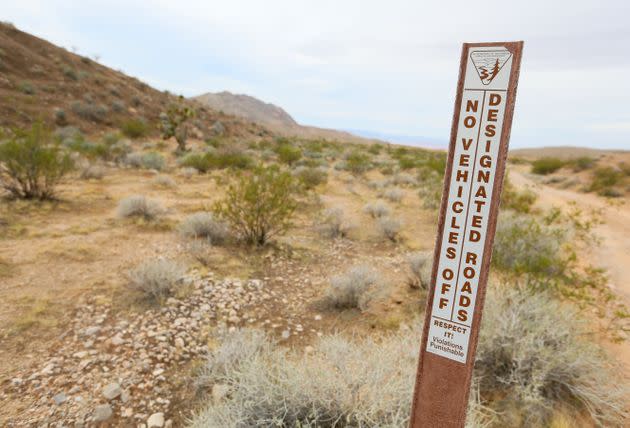
A Bureau of Land Management sign stands near a designated road in Gold Butte, Nevada.
‘A cry for help’
The BLM, which is part of the Interior Department, oversees 245 million acres of federal public land — more than one-third of all federally managed acres in the U.S. — and has an at-times bifurcated “multiple-use” mandate to simultaneously manage development on public lands while safeguarding natural, cultural and historic resources for current and future generations. In other words, it must strike a balance between commerce, recreation and conservation.
But over its nearly 80-year history, the agency has largely dropped the ball on its stewardship mandate. Today, 90% of BLM land is open to drilling and 60% is leased for grazing, while less than 14% is protected from development. At least 54 million acres — one-fifth of all BLM land — fall short of the agency’s own land-health standards, degradation that is primarily driven by unsustainable livestock grazing, according to a 2022 analysis by watchdog organization Public Employees for Environmental Responsibility.
President Joe Biden’s BLM isn’t shying away from this reality, noting in its proposed rule that “public lands are increasingly degraded and fragmented due to adverse impacts from climate change and a significant increase in authorized use.”
Conservation leasing could help to turn the tide by opening the door for private citizens to fill well-documented funding and resource gaps at the federal bureau.
Madeleine West, director of public lands at the Theodore Roosevelt Conservation Partnership, called the BLM rule a “cry for help.”
“The BLM is not maintaining quality land, broadly, and they don’t right now feel they can do it with the regulations and resources that they have,” West said. “So they’re putting some new ideas on the table, like conservation leasing, to try to give them those resources. If you don’t like this rule, then I suppose you’re fine with BLM-managed lands largely being developed.”
Along with issuing and monitoring conservation leases, the rule directs the BLM to incorporate land health assessments into land use decisions and to prioritize the creation of new “areas of critical environmental concern” — an agency designation that limits environmentally harmful activities like mining and drilling.
Unsurprisingly, the rule has further spotlighted the fierce political tug of war over the future of federal lands and waters. Industry and its allies have made clear they are happy with the lopsided status quo.
In an interview with S&P Global, Mallori Miller, vice president of government relations for the Independent Petroleum Association of America, an industry trade group, lamented that historically “there was never a choice between mineral extraction or conservation but now the door is open.”
“This rule is a complete shift of mindset and priority that is not consistent with the way federal land has ever been managed since the 1800s,” she told the publication. “This is incredibly concerning for any competing interests.”
Rep. Matt Rosendale (R-Mont.) went as far as to argue that conservation is “not supposed to be on equal footing” with grazing and other uses. He said the rule would directly conflict with the Taylor Grazing Act, the 1934 law that regulates grazing on public lands.
And in an exchange with Haaland during a budget hearing on Tuesday, Sen. John Barrasso (R-Wyo.) slammed the BLM proposal as “nothing more than a thinly veiled attempt to eliminate economic activities on federal lands in Wyoming and across the West.”
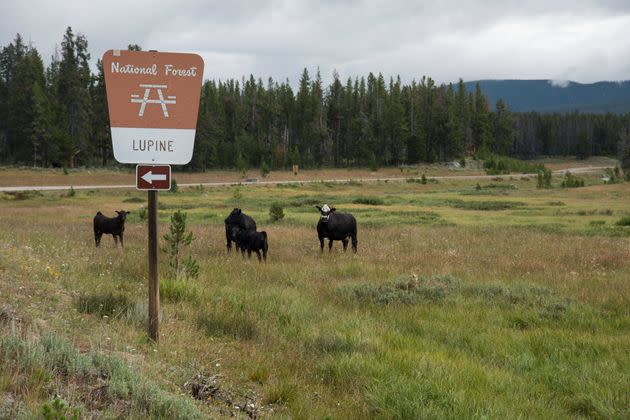
Cattle graze on U.S. Forest Service land in the Beaverhead-Deerlodge National Forest in Montana. The 2015 grazing fee is $1.69 per animal unit month (cow and calf).
But the pro-development status quo that Rosendale, Barrasso and others want to protect has had deleterious effects.
“For many years, we have been subsidizing private companies by allowing them to degrade public lands and not asking them to pay for the damage,” said Sara Brodnax, director of public lands policy at the National Audubon Society. “Simply put, the status quo has been privatization of public lands.”
O’Shea agrees it’s past time for a major shift.
“Business as usual, the way we’ve treated public lands in the past, really has not gotten us to a great place,” she said. “If we don’t start thinking differently and creatively, things are not going to improve.”
The draft rule is open for public comment until June 20. More than 10,000 comments have already been submitted, which gives a taste of the battle that is going to play out over what activities should be allowed on lands leased for conservation.
“Any land subject to a conservation lease must be available for leasing for oil, gas and mineral resources in the subsurface,” one anonymous commenter wrote.
A growing push
Leasing public lands to safeguard them from development is not a new idea. And without a formal system to do so, activists have tried unsuccessfully within existing federal leasing programs.
Climate activist Tim DeChristopher spent 21 months in prison after “monkeywrenching” an oil and gas lease sale in Utah in 2008. The then-27-year-old University of Utah student successfully bid on 14 parcels valued at $1.8 million without any intention of drilling or paying the government.
In 2016, writer and activist Terry Tempest Williams and her husband formed a company, Tempest Exploration Co. LLC, and purchased two oil and gas leases on 1,120 federal acres near their home in Grand County, Utah. The BLM subsequently revoked the leases after Williams wrote in an op-ed in The New York Times that she planned to “keep whatever oil and gas lies beneath these lands in the ground” until “science finds a way to use those fossil fuels in sustainable, nonpolluting ways.” At the time, the BLM said it had “little choice” but to cancel the leases since the Mineral Leasing Act of 1920 requires lease holders to “exercise reasonable diligence in developing and producing.”
While fossil fuel companies are able to stockpile leases, often for less than $2 per acre, and sit on them for years without ever producing a drop, the Williamses were told to take a hike.
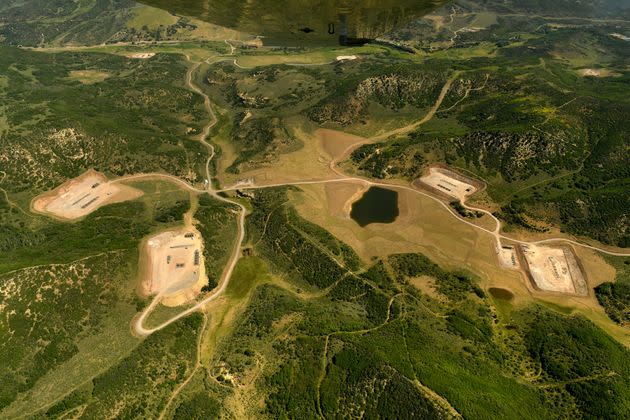
An aerial view of gas and oil development in the Plateau Creek Drainage in western Colorado.
Few people have done more to advance the idea of conservation leases than Shawn Regan, vice president of research at the Property and Environment Research Center, or PERC, a right-wing, Montana-based think tank that promotes “free market environmentalism” and has historical ties to fossil fuels. Regan points to Williams’ and DeChristopher’s cases to highlight how legacy “use it or lose it” rules have biased public land management in favor of extraction.
“We have these ‘use it or lose it’ requirements that define ‘use’ in these really narrow ways that preclude conservation groups from participating in the leasing markets that affect the use of vast swaths of the American West,” he told HuffPost. “Conservation should be considered a valid use of public lands, and groups should be able to acquire those leases and decide to conserve them in some form or restore them.”
Regan argues the inability of conservationists to participate in federal land leasing, even when they are willing to pay more than a driller or rancher, has only helped fuel conflict in Western states.
“Land management in the West, especially on public lands, is really a controversial issue. It generates a lot of political and legal conflict,” he said. “There’s not a way for these groups to negotiate to increase conservation on public lands. They basically have to fight it out in the political arena or through litigation. So there’s a ton of that.”
“Why don’t environmentalists just buy what they want to protect? Well, in many cases they can’t,” Regan said.
‘Devil is in the details’
The forthcoming conservation leases are likely to fall into two main categories: “mitigation” and “restoration or land enhancement.”
On the mitigation side, a solar developer might obtain a conservation lease to offset damage a commercial project causes to wetlands or wildlife habitat, perhaps as a condition of a development permit. Alternatively, individuals or organizations could voluntarily step up to conserve or improve public lands. For example, a major environmental organization might propose using privately secured funds to restore a degraded watershed.
Asked about specific projects that might fit within the new framework, O’Shea pointed to human-made structures called “beaver dam analogs” that mimic natural beaver dams, slowing water flows and improving water quality.
“Whether or not that is going to be the kind of thing that BLM includes in conservation leases, I don’t want to presume,” she said. “But it’s certainly a very climate-resilient, climate-friendly kind of restoration. And that’s what I hope we’ll see — restoration for biodiversity, climate and communities.”
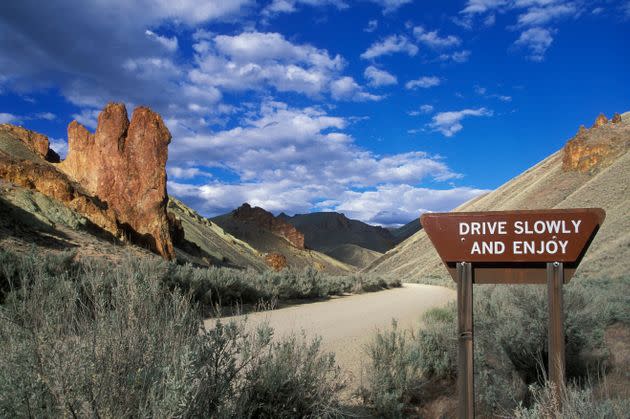
A Bureau of Land Management sign welcomes visitors to Leslie Gulch in southeast Oregon.
Regan sees existing partnerships on private lands as a potential model for federal conservation leasing.
“There are a lot of very effective new, voluntary tools being developed to enhance private land conservation, including occupancy agreements, habitat leases, etc.,” he said.
In 2021, a multi-generation ranching family in Montana’s Paradise Valley, just north of Yellowstone National Park, entered into a unique agreement with PERC to protect 500 acres of winter-range habitat for elk. Under the “elk occupancy agreement,” the ranchers set aside a chunk of their private land as elk habitat in exchange for PERC paying for a 1.25-mile wildlife-friendly fence to keep the family’s cattle from grazing on the parcel. The project is the first of its kind in Montana, according to PERC, which spearheaded the agreement with the help of other conservation organizations.
Regan noted that such an agreement would not have been allowed on a grazing allotment on public land, as it would have violated the terms of the lease. “There is not a legal authority to acquire a grazing lease or a portion of a grazing lease, or even negotiate with a leaseholder to modify grazing practices,” he said.
The BLM rule specifically states that conservation leases “would not override valid existing rights” or prevent future development approvals as long as they are “compatible with the conservation use.” But it is unclear to what extent, if any, the BLM will greenlight conservation leases in areas with existing drilling, mining and grazing.
West, O’Shea and others said they are encouraged to see the BLM asking specific questions of the public as it tries to build a conservation leasing framework. As part of its public comment period, the BLM is seeking input on whether certain lands should be off-limits to conservation leasing, if the rule should clarify specific actions allowed under a conservation lease, and whether leases should be limited to protecting specific resources.
“Building out a new program or a new tool is always complicated,” O’Shea said. “With all things, the devil is in the details. You have to roll up your sleeves and figure out how we actually make this work.”
Risks and guardrails
While environmental advocates largely agree that conservation leases are a step in the right direction, some experts warn that the proposal is not without risks and stress the importance of establishing guardrails to prevent unintended consequences.
While mitigating adverse environmental impacts from development is a positive thing, the new BLM rule could potentially open the door for conservation leases being used to justify greenlighting projects that cause unnecessary harm to other public lands, Mark Squillace, a professor of natural resources law at the University of Colorado Boulder, told HuffPost.
“I’m largely positive about the proposal,” he said. “But I do think that it raises some questions. Obviously it would be nice to have some mitigation of adverse impacts if they are going to occur anyway, but I don’t think we should use it as an excuse to allow some things that we otherwise would not allow on public lands.”
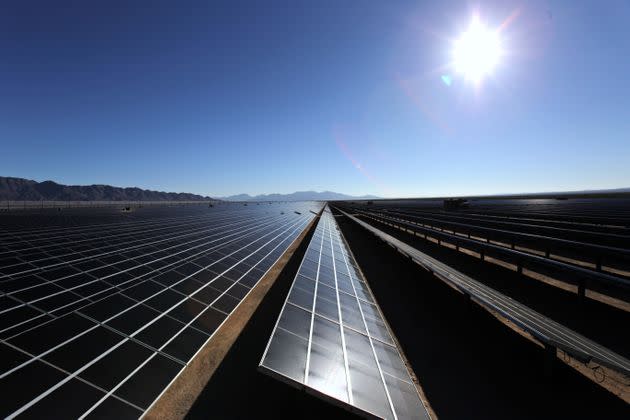
The 550-megawatt Desert Sunlight Solar Farm is one of the world's largest of its kind, sitting on 3,800 acres of federal land in Desert Center, California.
Squillace also worries about legal issues that could arise from the BLM outsourcing a portion of its stewardship mandate.
“One of the things that makes me nervous about this proposal is the idea that the government is turning over to the private sector, even NGOs, their responsibility to protect and conserve our public lands,” he said. “Right from the get-go, you have to worry that this is a government responsibility and why are they delegating this to a private concern.”
Squillace recognizes staffing and resource constraints at the BLM, but said it will likely prove much harder to hold a third party responsible if it fails to comply with requirements of a conservation lease or follow through on land restoration work.
“Even people with the best of intentions holding some of these conservation leases may not have the expertise or the resources or the wherewithal to actually accomplish what they are doing,” he said. “At the same, time they may feel empowered or willing, at least, to keep the public out of some of these public areas.”
Regan’s main concern is that the rule will fall short of something that allows for competing interests to negotiate and resolve conflicts over public lands. If the BLM ultimately decides that conservation leases can only be obtained in areas not currently open to extraction and other uses, that would severely limit the opportunities under this new leasing framework.
“How much land are we talking about here and where is it?” he said. “And then what are the opportunities for conservation and restoration on that remaining sliver?”
Instead of creating an entirely new, complex system of leasing specific to conservation work, as the BLM is proposing, Regan supports reforming existing oil and gas, mining and grazing leasing programs to enable conservation as a valid use.
Several experts HuffPost talked to agreed that robust monitoring will be critical to the success of a future conservation leasing program.
“Monitoring has always been a challenging piece of the conservation lifecycle,” O’Shea said. “There are sort of two goals. Are you meeting whatever the objectives were of your restoration or conservation effort? And then how do you take that information and learn from it? That’s never more critical than it is now with climate change and trying to figure out what do species need, what do habitats and vegetation types need, in terms of management, if they are going to thrive under the extreme stress of climate change.”
Squillace said the BLM in particular has a poor track record of keeping tabs on activities it approves on public lands.
“That’s how we’re going to tell if it’s working or not,” he said of monitoring. “It just happens too often with the government — they make a decision and they kind of walk away from it. And the person who’s implementing the decision does what they want or they do things different from what was approved and there’s nobody that’s checking.”
This story has been updated to provide additional context about PERC’s funding.

